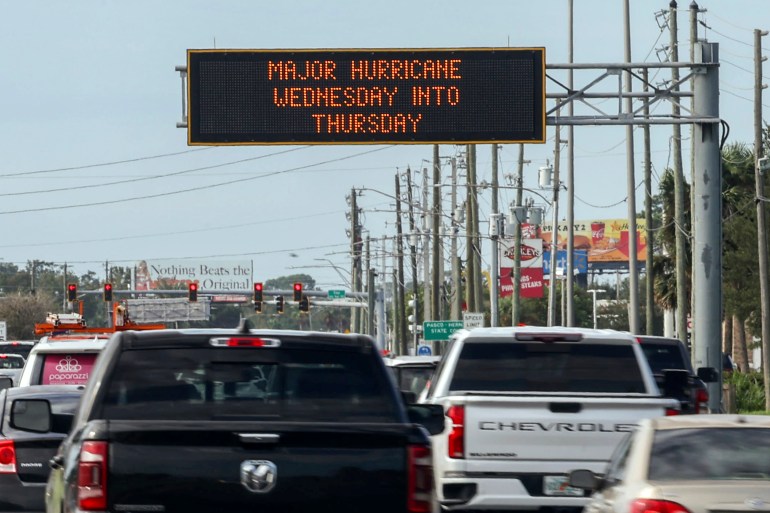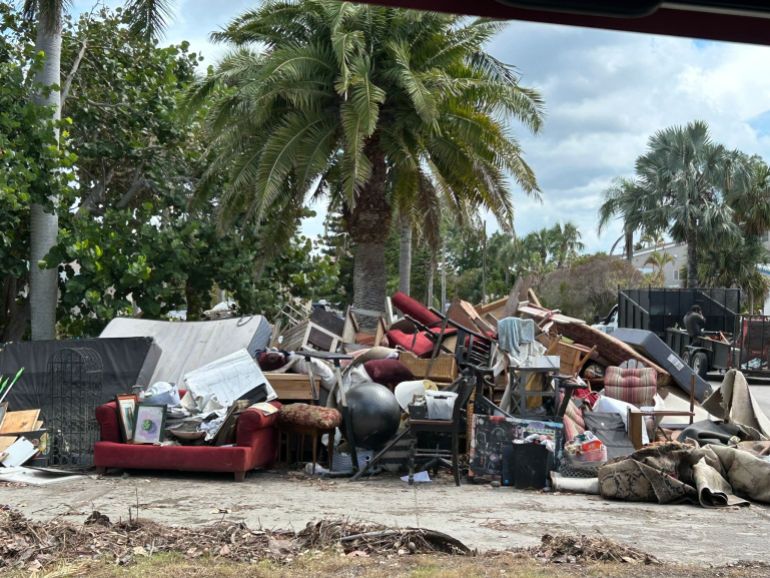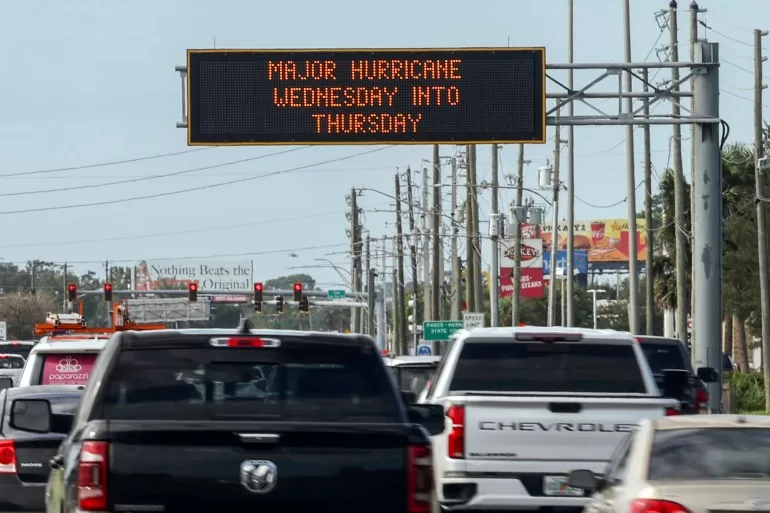Hurricane Milton has weakened but remains a major Category 4 hurricane in the southwestern Gulf of Mexico, threatening to flood the west coast of Florida with historic storm surge.
Almost the entirety of the west coast of Florida was under a hurricane or tropical storm warning on Tuesday as the storm’s 230km/h (145mph) winds spun towards Tampa Bay, one of the largest urban areas of the state, sucking energy from the Gulf of Mexico’s warm waters.
A massive evacuation is already under way as residents of the Tampa Bay area head inland, seeking shelter after Milton rapidly strengthened from a tropical storm to a major Category 5 hurricane on Monday.
“This is the real deal here with Milton,” the mayor of Tampa, Jane Castor, told a news conference. “If you want to take on Mother Nature, she wins 100 percent of the time.”
In an interview with CNN, Castor issued a dire warning to residents of her city. “This is literally catastrophic and I can say without any dramatization whatsoever, if you choose to stay in one of those evacuation areas, you’re going to die,” she said.
“This is something that I’ve never seen in my life and I can tell you that anyone who was born and raised in the Tampa Bay area has never seen anything like this before.”

Storm surge
A storm surge warning has been issued for coastal Southwest Florida with some areas including Tampa Bay forecast to get 10-to-15 feet of storm surge (3m to 4.5m).
“That level of storm surge would be catastrophic for the Tampa metro area, inundating low-lying areas,” Phil Klotzbach, a meteorologist at Colorado State University, told Al Jazeera.
The storm is about 870km (545 miles) southwest of Tampa as of the latest advisory from the National Hurricane Center (NHC), and has picked up in forward speed now moving to the east-northeast at 15km/h (9mph).
#HurricaneMilton looking very impressive and sadly likely very damaging for #Florida natives.
Stay up to date with the great service provided by #NOAAhttps://t.co/sZ5J0JA3yI#HurricaneMilton pic.twitter.com/ARc0Vj7gxl
— Mark Bowe (@Mark__Bowe) October 8, 2024
“While fluctuations in intensity are expected, Milton is forecast to remain an extremely dangerous hurricane through landfall in Florida,” the NHC said.
Hurricane-force winds extend outward up to 45km (30 miles) from the centre, but the wind field is expected to nearly double in size as the storm nears landfall late Wednesday night into early Thursday morning.
Tampa Bay is still recovering from Hurricane Helene less than two weeks ago, which reported seven feet (2m) of storm surge, according to the National Weather Service.
“West coast Florida residents like myself are looking at as much as 15 feet (4.5m) of storm surge – double what we saw with hurricane Helene,” said Susan Glickman, with the CLEO Institute, a nonprofit dedicated to climate education and advocacy.
Glickman’s home in Belleair Beach, a barrier island just north of Tampa, was flooded during Helene and the contents destroyed.

Vulnerable urban population
With a population of almost four million people, Tampa Bay is one of the most vulnerable areas of the country to flooding from a powerful storm.
“It’s a huge population. It’s very exposed, very inexperienced, and that’s a losing proposition,” Massachusetts Institute of Technology meteorology professor Kerry Emanuel said. “I always thought Tampa would be the city to worry about most.”
Tampa is also the US city with the highest risk of flooding from a hurricane, according to a report by the consulting firm Karen Clark and Company, and the seventh-most at-risk city in the world, according to the World Bank.
The risk to Tampa stems in part from not having suffered the direct impact of a major hurricane for almost a century, with few buildings constructed to withstand such large storms.
The Tampa Bay region has not suffered a direct impact from a major Category 3 or greater hurricane in nearly a century.
The last time it was hit came in 1921; a Category 3 hurricane with winds of 115 miles per hour (185 kms/h) that caused severe damage. Then, only 160,000 people lived in the four counties of the Tampa metropolitan area, mostly in highland areas.
The 1921 Tampa Bay hurricane generated an 11-foot (3.3m) storm surge, said Klotzbach. The last time the bay experienced anything close to 15 feet was the 1848 Tampa Bay Hurricane, he added.
Another risk factor is the continental shelf, a submarine geological formation sticking out from the west coast of the Florida peninsula, resulting in shallow water less than 300 feet (90m) deep that extends 140km (90 miles) offshore.
As a result, the effects of sea level rise are more severe on the west coast of Florida than in the east which faces the deeper Atlantic ocean, meteorologists say.
Mitigation
Despite this risk, the region has not taken sufficient steps to mitigate the effect of rising sea levels, environmental activists say. Few buildings in the Tampa Bay area were built with modern hurricane safety codes.
Some key facilities could have their flood protections severely tested by Milton, such as the 100-year-old Tampa General Hospital, which sits on an island just off downtown Tampa.
The hospital perimetre is protected by the so-called AquaFence, a water-impermeable barrier that can withstand storm surges up to 15 feet (4.5m) above sea level. It requires a team of 60 and three days to complete installation before a storm.
Florida taking a battering
Milton will be the third hurricane to thrash Florida in just 13 months, including Helene which killed 227 people, mostly in North Carolina.
Other parts of Florida’s Gulf Coast are still recovering from previous storms. The Fort Myers area in southwest Florida is still rebuilding from Hurricane Ian in 2022, which caused $112bn in damage.
It has been two decades since so many storms crisscrossed Florida in such a short period of time. In 2004, an unprecedented five storms struck Florida within six weeks, including three hurricanes that pummeled central Florida.
Many environmentalists point the finger at climate change for the increased intensity of recent storms.
“Our home is unlivable and we are evacuating inland but I can barely contain my rage at the oil companies that have allowed unchecked climate pollution so they can profit,” said Glickman.
“The warming from climate pollution is causing seas to rise, extreme heat, monster hurricanes and storm surge,” she added.
